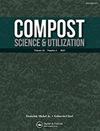不同堆肥产品对马铃薯土传病害的影响
IF 0.9
4区 农林科学
Q3 ECOLOGY
引用次数: 9
摘要
土传病害是马铃薯生产者的重大经济损失。施用堆肥可以减少土传病害,但堆肥产品对马铃薯病害严重程度和发病率的影响尚不清楚。通过田间和室内试验,比较了不同堆肥产品对加拿大新不伦瑞克省马铃薯土传病害的防治效果。在田间,于2014年10月和2015年10月在田间地块施用45 Mg ha−1干重的5种产品。在生长室试验中,将7种产品与自然侵染土壤按5% w/w的比例混合。评估了块茎的疾病严重程度和发病率,并与不添加堆肥的对照进行了比较。银屑、黑屑(BS)、普通痂(CS)和粉状痂的症状严重程度因治疗、实验和年份而异。在2016年的田间试验中,对照组的BS严重程度显著高于禽粪堆肥处理(3.26%比0.90%)。田间常见赤霉病的严重程度和发生率与土壤pH呈正相关,与土壤颗粒有机质C和堆肥C浓度呈负相关。在生长室试验中,对照的CS严重程度(8.98%)显著高于城市源分离有机堆肥处理和海洋垃圾堆肥处理(分别为1.72%和2.47%)。在本研究中,堆肥产品对马铃薯土传病害有显著但不一致的抑制作用。在本研究中,堆肥C的数量,而不是堆肥质量,可能是抑制病害的最重要因素。本文章由计算机程序翻译,如有差异,请以英文原文为准。
Effect of Diverse Compost Products on Soilborne Diseases of Potato
ABSTRACT Soilborne diseases result in major economic losses for potato producers. Compost application can reduce soilborne diseases, however the effects of compost products on potato disease severity and incidence are still unclear. Diverse compost products were compared for their effects on soilborne diseases of potato in New Brunswick, Canada using field and growth room experiments. In the field, five products were applied at 45 Mg ha−1 dry weight to field plots in October of 2014 and 2015. In the growth room experiment, seven products were mixed to a 5% w/w ratio with naturally infested soil. Tubers were assessed for disease severity and incidence and compared with a no compost addition control. Severity of symptoms of silver scurf, black scurf (BS), common scab (CS), and powdery scab varied among treatments, experiments, and years. In the field experiment, BS severity was significantly greater in the control than in the poultry manure compost treatment (3.26% versus 0.90%) in 2016. Common scab severity and incidence in the field were positively related to soil pH and negatively related to soil particulate organic matter C and compost C concentrations. In the growth room experiment, CS severity was significantly greater in the control (8.98%) than in the municipal source separated organic compost and sea-waste compost treatments (1.72 and 2.47%, respectively). In this study, compost products had a significant, but inconsistent, suppressive effect on soilborne potato diseases. The quantity of compost C, rather than compost quality, was likely the most important factor in disease suppression in this study.
求助全文
通过发布文献求助,成功后即可免费获取论文全文。
去求助
来源期刊

Compost Science & Utilization
农林科学-生态学
CiteScore
4.10
自引率
0.00%
发文量
0
审稿时长
>36 weeks
期刊介绍:
4 issues per year
Compost Science & Utilization is currently abstracted/indexed in: CABI Agriculture & Environment Abstracts, CSA Biotechnology and Environmental Engineering Abstracts, EBSCOhost Abstracts, Elsevier Compendex and GEOBASE Abstracts, PubMed, ProQuest Science Abstracts, and Thomson Reuters Biological Abstracts and Science Citation Index
 求助内容:
求助内容: 应助结果提醒方式:
应助结果提醒方式:


